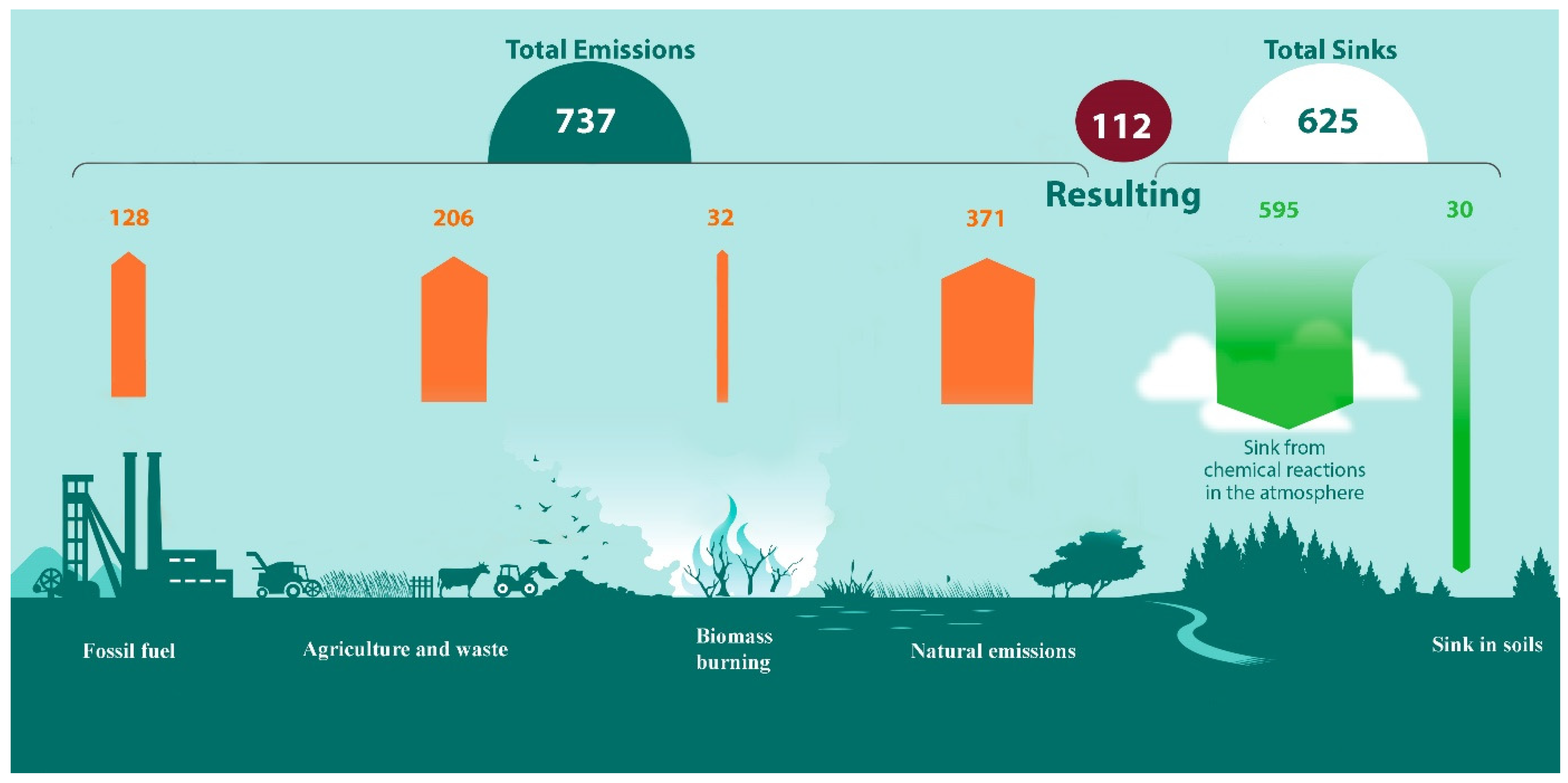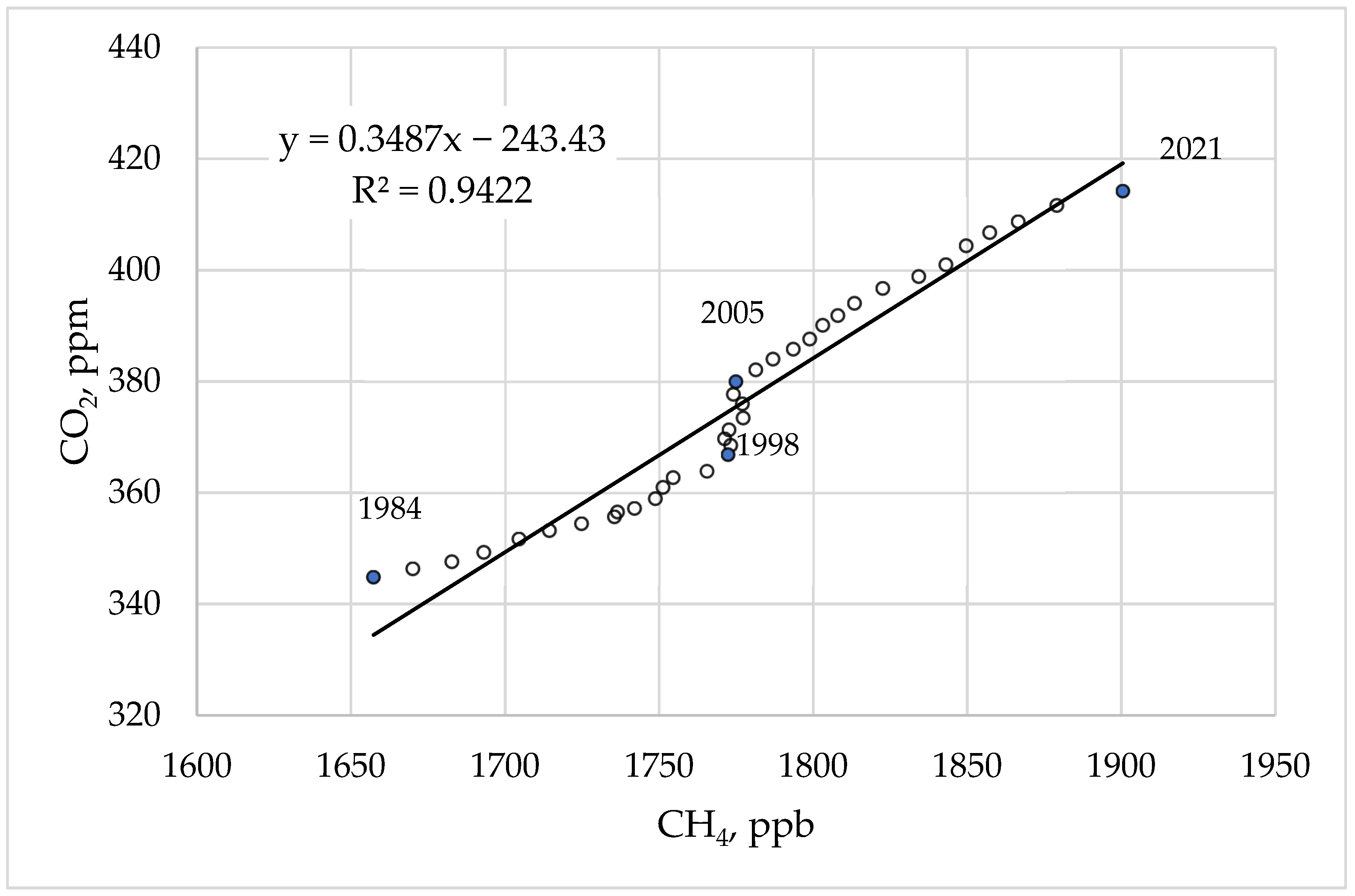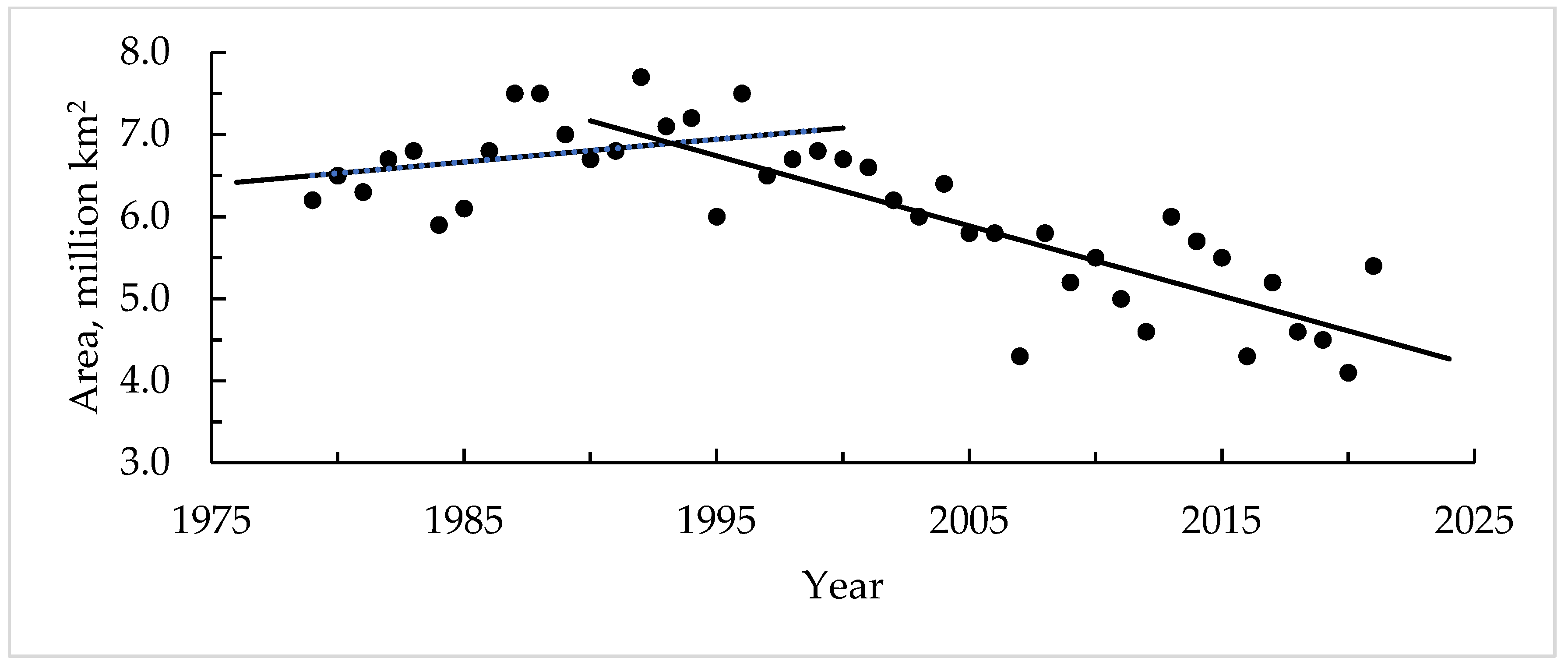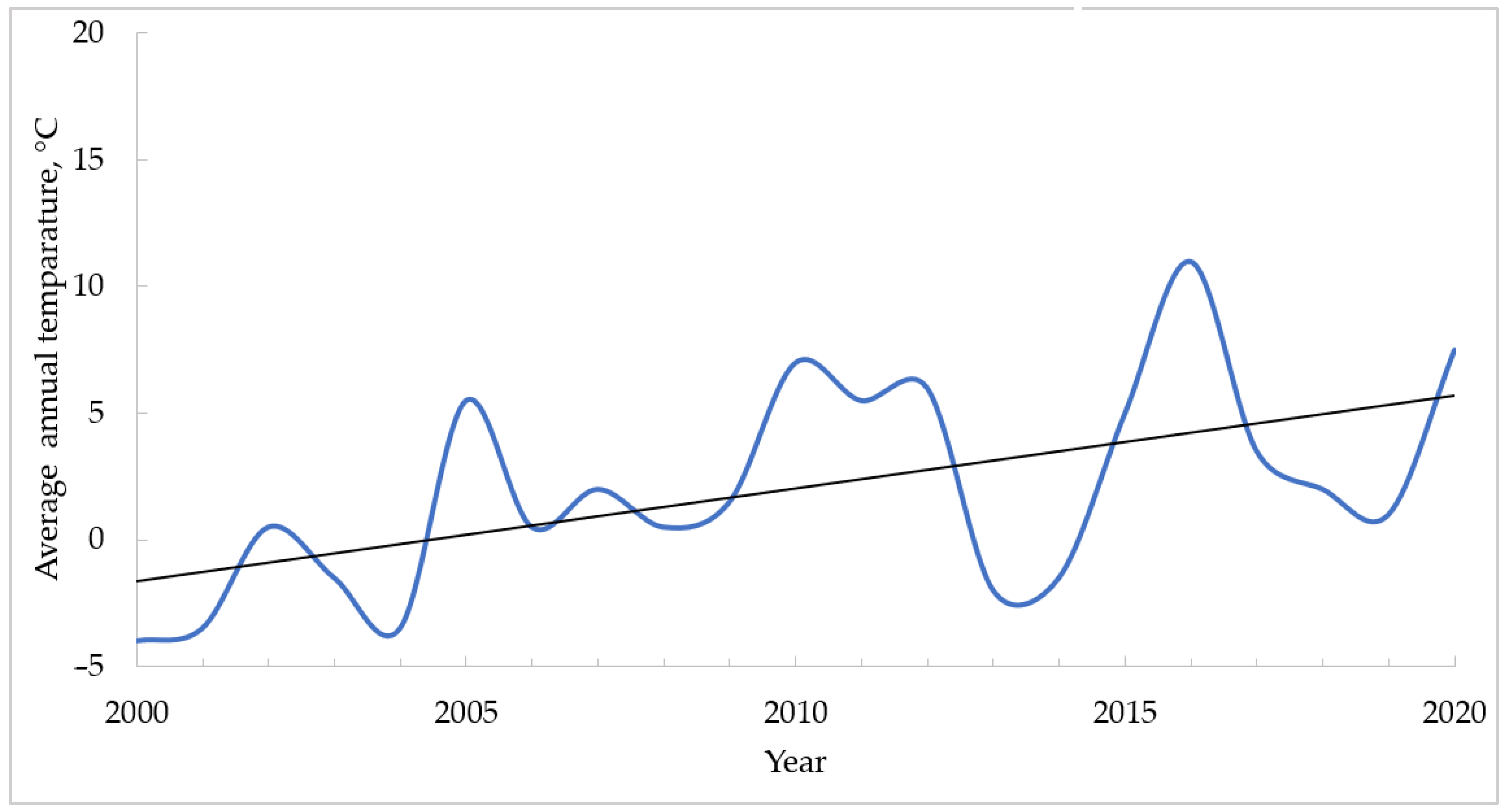Sources of Carbon Dioxide in the Atmosphere: Hydrocarbon Emission from Gas Hydrates in Focus
Abstract
:1. Introduction
2. Materials and Methods
2.1. Data Sources and Selection
2.2. Global Carbon Dioxide Budget Data
- fossil fuel combustion and oxidation from all energy and industrial processes, including cement production and carbonation (35 GtCO2·y−1).
- the emissions from land use, land-use change, and forestry (5 GtCO2·y−1).
- land uptake (11 GtCO2·y−1).
- ocean uptake (10 GtCO2·y−1).
2.3. Global Methane Budget Data
2.4. CH4 and CO2 Concentrations in the Atmosphere from 1984 to 2021
2.5. Estimations for Possible CH4 Amount Released from the Shallow Arctic Shelf
2.6. Change in the Square Area of Ice Cover in the Arctic for the Period 1979–2021
3. Results and Discussion
3.1. The Amount of CO2 and CH4 in the Atmosphere
3.2. CH4 and Other Hydrocarbons in Gas Hydrates
3.3. Correlation between CO2 and CH4 Concentrations in the Atmosphere
3.4. The Origin of CH4 and Its Homologues in Gas Hydrates
3.5. The Thawing of Gas Hydrates—The Current State
4. Conclusions
Author Contributions
Funding
Institutional Review Board Statement
Informed Consent Statement
Data Availability Statement
Conflicts of Interest
References
- Field, C.B.; Raupach, M.R. The Global Carbon Cycle: Integrating Humans, Climate, and the Natural World; Island Press: Washington, DC, USA, 2004; Volume 62. [Google Scholar]
- Canadell, J.G.; Pataki, D.E.; Pitelka, L.F. Terrestrial Ecosystems in a Changing World; Springer Science & Business Media: Berlin/Heidelberg, Germany, 2007. [Google Scholar]
- Tans, P.; Keeling, D. Trends in Atmospheric Carbon Dioxide; U.S. Department of Commerce, Global Monitoring Laboratory: Gaithersburg, MD, USA, 2022.
- Peters, G.P.; Andrew, R.M.; Canadell, J.G.; Friedlingstein, P.; Jackson, R.B.; Korsbakken, J.I.; Le Quéré, C.; Peregon, A. Carbon dioxide emissions continue to grow amidst slowly emerging climate policies. Nat. Clim. Change 2020, 10, 3–6. [Google Scholar] [CrossRef]
- Friedlingstein, P.; O’Sullivan, M.; Jones, M.W.; Andrew, R.M.; Gregor, L.; Hauck, J.; Le Quéré, C.; Luijkx, I.T.; Olsen, A.; Peters, G.P.; et al. Global Carbon Budget 2022. Earth Syst. Sci. Data 2022, 14, 4811–4900. [Google Scholar] [CrossRef]
- Guimberteau, M.; Ciais, P.; Ducharne, A.; Boisier, J.P.; Dutra Aguiar, A.P.; Biemans, H.; De Deurwaerder, H.; Galbraith, D.; Kruijt, B.; Langerwisch, F.; et al. Impacts of future deforestation and climate change on the hydrology of the Amazon Basin: A multi-model analysis with a new set of land-cover change scenarios. Hydrol. Earth Syst. Sci. 2017, 21, 1455–1475. [Google Scholar] [CrossRef]
- Gasser, T.; Crepin, L.; Quilcaille, Y.; Houghton, R.A.; Ciais, P.; Obersteiner, M. Historical CO2 emissions from land use and land cover change and their uncertainty. Biogeosciences 2020, 17, 4075–4101. [Google Scholar] [CrossRef]
- Qin, Y.; Xiao, X.; Wigneron, J.-P.; Ciais, P.; Brandt, M.; Fan, L.; Li, X.; Crowell, S.; Wu, X.; Doughty, R. Carbon loss from forest degradation exceeds that from deforestation in the Brazilian Amazon. Nat. Clim. Change 2021, 11, 442–448. [Google Scholar] [CrossRef]
- Cicerone, R.J.; Oremland, R.S. Biogeochemical aspects of atmospheric methane. Glob. Biogeochem. Cycles 1988, 2, 299–327. [Google Scholar] [CrossRef]
- Saunois, M.; Stavert, A.R.; Poulter, B.; Bousquet, P.; Canadell, J.G.; Jackson, R.B.; Raymond, P.A.; Dlugokencky, E.J.; Houweling, S.; Patra, P.K.; et al. The Global Methane Budget 2000–2017. Earth Syst. Sci. Data 2020, 12, 1561–1623. [Google Scholar] [CrossRef]
- Pohlman, J.W.; Greinert, J.; Ruppel, C.; Silyakova, A.; Vielstädte, L.; Casso, M.; Mienert, J.; Bünz, S. Enhanced CO2 uptake at a shallow Arctic Ocean seep field overwhelms the positive warming potential of emitted methane. Proc. Natl. Acad. Sci. USA 2017, 114, 5355–5360. [Google Scholar] [CrossRef]
- Kvenvolden, K.A. Methane hydrates and global climate. Glob. Biogeochem. Cycles 1988, 2, 221–229. [Google Scholar] [CrossRef]
- Ruppel, C.D.; Kessler, J.D. The interaction of climate change and methane hydrates. Rev. Geophys. 2017, 55, 126–168. [Google Scholar] [CrossRef]
- Thornton, B.F.; Geibel, M.C.; Crill, P.M.; Humborg, C.; Mörth, C.M. Methane fluxes from the sea to the atmosphere across the Siberian shelf seas. Geophys. Res. Lett. 2016, 43, 5869–5877. [Google Scholar] [CrossRef]
- Shakhova, N.; Semiletov, I.; Leifer, I.; Sergienko, V.; Salyuk, A.; Kosmach, D.; Chernykh, D.; Stubbs, C.; Nicolsky, D.; Tumskoy, V. Ebullition and storm-induced methane release from the East Siberian Arctic Shelf. Nat. Geosci. 2014, 7, 64–70. [Google Scholar] [CrossRef]
- Fetterer, F.; Knowles, K.; Meier, W.N.; Savoie, M.; Windnagel, A.K. Sea Ice Index, Version 3 [Data Set]. Boulder, Colorado USA. National Snow and Ice Data Center. 2017. Available online: https://nsidc.org/data/g02135/versions/3 (accessed on 20 December 2022).
- Trenberth, K.E.; Smith, L. The mass of the atmosphere: A constraint on global analyses. J. Clim. 2005, 18, 864–875. [Google Scholar] [CrossRef]
- Katzenstein, A.S.; Doezema, L.A.; Simpson, I.J.; Blake, D.R.; Rowland, F.S. Extensive regional atmospheric hydrocarbon pollution in the southwestern United States. Proc. Natl. Acad. Sci. USA 2003, 100, 11975–11979. [Google Scholar] [CrossRef]
- Simpson, I.J.; Sulbaek Andersen, M.P.; Meinardi, S.; Bruhwiler, L.; Blake, N.J.; Helmig, D.; Rowland, F.S.; Blake, D.R. Long-term decline of global atmospheric ethane concentrations and implications for methane. Nature 2012, 488, 490–494. [Google Scholar] [CrossRef]
- Etiope, G.; Ciccioli, P. Earth’s degassing: A missing ethane and propane source. Science 2009, 323, 478. [Google Scholar] [CrossRef] [PubMed]
- Guo, S.; Yang, F.; Tan, J.; Duan, J. Nonmethane hydrocarbons in ambient air of hazy and normal days in Foshan, South China. Environ. Eng. Sci. 2012, 29, 262–269. [Google Scholar] [CrossRef] [PubMed]
- Dlugokencky, E.J.; Nisbet, E.G.; Fisher, R.; Lowry, D. Global atmospheric methane: Budget, changes and dangers. Philos. Trans. R. Soc. A 2011, 369, 2058–2072. [Google Scholar] [CrossRef]
- Nisbet, E.G.; Dlugokencky, E.J.; Bousquet, P. Methane on the rise—Again. Science 2014, 343, 493–495. [Google Scholar] [CrossRef]
- Prather, M.J.; Holmes, C.D. Overexplaining or underexplaining methane’s role in climate change. Proc. Natl. Acad. Sci. USA 2017, 114, 5324–5326. [Google Scholar] [CrossRef] [Green Version]
- Feldman, D.R.; Collins, W.D.; Biraud, S.; Risser, M.; Turner, D.; Gero, P.J.; Tadić, J.; Helmig, D.; Xie, S.; Mlawer, E.J. Observationally derived rise in methane surface forcing mediated by water vapour trends. Nat. Geosci. 2018, 11, 238–243. [Google Scholar] [CrossRef]
- The Global Monitoring Laboratory of the National Oceanic and Atmospheric Administration. Available online: https://gml.noaa.gov/aftp/data/ (accessed on 20 December 2022).
- Milkov, A.V. Global estimates of hydrate-bound gas in marine sediments: How much is really out there? Earth-Sci. Rev. 2004, 66, 183–197. [Google Scholar] [CrossRef]
- Speight, J.G. Handbook of Industrial Hydrocarbon Processes; Gulf Professional Publishing: Oxford, UK, 2019. [Google Scholar]
- Kvenvolden, K.A.; Lorenson, T.D. The global occurrence of natural gas hydrate. Geophys. Monogr. Ser. 2001, 124, 3–18. [Google Scholar] [CrossRef]
- Hornbach, M.J.; Saffer, D.M.; Steven Holbrook, W. Critically pressured free-gas reservoirs below gas-hydrate provinces. Nature 2004, 427, 142–144. [Google Scholar] [CrossRef] [PubMed]
- Kutcherov, V.G.; Krayushkin, V.A. Deep-Seated Abiogenic Origin of Petroleum: From Geological Assessment to Physical Theory. Rev. Geophys. 2010, 48, 1–30. [Google Scholar] [CrossRef]
- Bousquet, P.; Ciais, P.; Miller, J.; Dlugokencky, E.J.; Hauglustaine, D.; Prigent, C.; Van der Werf, G.; Peylin, P.; Brunke, E.-G.; Carouge, C. Contribution of anthropogenic and natural sources to atmospheric methane variability. Nature 2006, 443, 439–443. [Google Scholar] [CrossRef]
- Bousquet, P.; Pierangelo, C.; Bacour, C.; Marshall, J.; Peylin, P.; Ayar, P.V.; Ehret, G.; Bréon, F.M.; Chevallier, F.; Crevoisier, C. Error budget of the MEthane Remote LIdar missioN and its impact on the uncertainties of the global methane budget. J. Geophys. Res. Atmos. 2018, 123, 11766–11785. [Google Scholar] [CrossRef]
- Kirschke, S.; Bousquet, P.; Ciais, P.; Saunois, M.; Canadell, J.G.; Dlugokencky, E.J.; Bergamaschi, P.; Bergmann, D.; Blake, D.R.; Bruhwiler, L. Three decades of global methane sources and sinks. Nat. Geosci. 2013, 6, 813–823. [Google Scholar] [CrossRef]
- Zhao, Y.; Saunois, M.; Bousquet, P.; Lin, X.; Berchet, A.; Hegglin, M.I.; Canadell, J.G.; Jackson, R.B.; Dlugokencky, E.J.; Langenfelds, R.L. Influences of hydroxyl radicals (OH) on top-down estimates of the global and regional methane budgets. Atmos. Chem. Phys. 2020, 20, 9525–9546. [Google Scholar] [CrossRef]
- Global Anthropogenic Non-CO2 Greenhouse Emissions: 1990–2030. U.S. Environmental Protection Agency. Available online: https://www.epa.gov/global-mitigation-non-co2-greenhouse-gases/global-non-co2-ghg-emissions-1990-2030 (accessed on 20 December 2022).
- Schaefer, H.; Fletcher, S.E.M.; Veidt, C.; Lassey, K.R.; Brailsford, G.W.; Bromley, T.M.; Dlugokencky, E.J.; Michel, S.E.; Miller, J.B.; Levin, I. A 21st-century shift from fossil-fuel to biogenic methane emissions indicated by 13CH4. Science 2016, 352, 80–84. [Google Scholar] [CrossRef] [PubMed]
- Rigby, M.; Prinn, R.G.; Fraser, P.J.; Simmonds, P.G.; Langenfelds, R.; Huang, J.; Cunnold, D.M.; Steele, L.P.; Krummel, P.B.; Weiss, R.F. Renewed growth of atmospheric methane. Geophys. Res. Lett. 2008, 35, 1–6. [Google Scholar] [CrossRef]
- Kolesnikov, A.; Kutcherov, V.G.; Goncharov, A.F. Methane-derived hydrocarbons produced under upper-mantle conditions. Nat. Geosci. 2009, 2, 566–570. [Google Scholar] [CrossRef]
- Kudryavtsev, D.; Serovaiskii, A.; Mukhina, E.; Kolesnikov, A.; Gasharova, B.; Kutcherov, V.; Dubrovinsky, L. Raman and IR Spectroscopy Studies on Propane at Pressures of Up to 40 GPa. J. Phys. Chem. A 2017, 121, 6004–6011. [Google Scholar] [CrossRef] [PubMed]
- Serovaiskii, A.; Kutcherov, V. Formation of complex hydrocarbon systems from methane at the upper mantle thermobaric conditions. Sci. Rep. 2020, 10, 4559. [Google Scholar] [CrossRef]
- Drachev, S.; Kaul, N.; Beliaev, V. Eurasia spreading basin to Laptev Shelf transition: Structural pattern and heat flow. Geophys. J. Int. 2003, 152, 688–698. [Google Scholar] [CrossRef]
- Cramer, B.; Franke, D. Indications for an active petroleum system in the Laptev Sea, NE Siberia. J. Pet. Geol. 2005, 28, 369–384. [Google Scholar] [CrossRef]
- Biastoch, A.; Treude, T.; Rüpke, L.H.; Riebesell, U.; Roth, C.; Burwicz, E.B.; Park, W.; Latif, M.; Böning, C.W.; Madec, G. Rising Arctic Ocean temperatures cause gas hydrate destabilization and ocean acidification. Geophys. Res. Lett. 2011, 38, 1–5. [Google Scholar] [CrossRef]
- Klauda, J.B.; Sandler, S.I. Global distribution of methane hydrate in ocean sediment. Energy Fuels 2005, 19, 459–470. [Google Scholar] [CrossRef]
- Shakhova, N.; Semiletov, I.; Chuvilin, E. Understanding the permafrost–hydrate system and associated methane releases in the East Siberian Arctic shelf. Geosciences 2019, 9, 251. [Google Scholar] [CrossRef]
- Notz, D. The future of ice sheets and sea ice: Between reversible retreat and unstoppable loss. Proc. Natl. Acad. Sci. USA 2009, 106, 20590–20595. [Google Scholar] [CrossRef] [PubMed] [Green Version]
- Hyndman, R.; Dallimore, S. Natural gas hydrate studies in Canada. Recorder 2001, 26, 11–20. [Google Scholar]
- Kvenvolden, K.A. Methane hydrate in the global organic carbon cycle. Terra Nova 2002, 14, 302–306. [Google Scholar] [CrossRef]
- Malakhova, V.; Golubeva, E. Model Study of the Effects of Climate Change on the Methane Emissions on the Arctic Shelves. Atmos 2022, 13, 274. [Google Scholar] [CrossRef]
- Reagan, M.T.; Moridis, G.J. Oceanic gas hydrate instability and dissociation under climate change scenarios. Geophys. Res. Lett. 2007, 34, 1–5. [Google Scholar] [CrossRef]
- Anderson, B.; Bartlett, K.; Frolking, S.; Hayhoe, K.; Jenkins, J.; Salas, W. Methane and Nitrous Oxide Emissions from Natural Sources; EPA 430-R-10-001; Office of Atmospheric Programs, US EPA: Washington, DC, USA, 2010.
- Shakhova, N.; Semiletov, I.; Salyuk, A.; Yusupov, V.; Kosmach, D.; Gustafsson, Ö. Extensive methane venting to the atmosphere from sediments of the East Siberian Arctic Shelf. Science 2010, 327, 1246–1250. [Google Scholar] [CrossRef]
- Berchet, A.; Bousquet, P.; Pison, I.; Locatelli, R.; Chevallier, F.; Paris, J.-D.; Dlugokencky, E.J.; Laurila, T.; Hatakka, J.; Viisanen, Y. Atmospheric constraints on the methane emissions from the East Siberian Shelf. Atmos. Chem. Phys. 2016, 16, 4147–4157. [Google Scholar] [CrossRef]
- Thornton, B.F.; Prytherch, J.; Andersson, K.; Brooks, I.M.; Salisbury, D.; Tjernström, M.; Crill, P.M. Shipborne eddy covariance observations of methane fluxes constrain Arctic sea emissions. Sci. Adv. 2020, 6, eaay7934. [Google Scholar] [CrossRef]
- Bussmann, I.; Hackbusch, S.; Schaal, P.; Wichels, A. Methane distribution and oxidation around the Lena Delta in summer 2013. Biogeosciences 2017, 14, 4985–5002. [Google Scholar] [CrossRef]
- Fenwick, L.; Capelle, D.; Damm, E.; Zimmermann, S.; Williams, W.J.; Vagle, S.; Tortell, P.D. Methane and nitrous oxide distributions across the North American Arctic Ocean during summer, 2015. J. Geophys. Res. Oceans 2017, 122, 390–412. [Google Scholar] [CrossRef]
- Tohjima, Y.; Zeng, J.; Shirai, T.; Niwa, Y.; Ishidoya, S.; Taketani, F.; Sasano, D.; Kosugi, N.; Kameyama, S.; Takashima, H. Estimation of CH4 emissions from the East Siberian Arctic Shelf based on atmospheric observations aboard the R/V Mirai during fall cruises from 2012 to 2017. Polar Sci. 2021, 27, 100571. [Google Scholar] [CrossRef]
- Angelopoulos, M.; Overduin, P.P.; Miesner, F.; Grigoriev, M.N.; Vasiliev, A.A. Recent advances in the study of Arctic submarine permafrost. Permafr. Periglac. Process. 2020, 31, 442–453. [Google Scholar] [CrossRef]





| The Source | Tg·y−1 |
|---|---|
| Natural sources | |
| Westlands | 149 |
| Other natural sources | 222 |
| Total natural sources | 371 |
| Anthropogenic sources | |
Agriculture and waste including
| 206 |
| 111 | |
| 65 | |
| 30 | |
Fossil fuels including
| 128 |
| 42 | |
| 80 | |
| 6 | |
| Biomass and biofuel burning | 32 |
| Total anthropogenic sources | 366 |
| Total sources | 737 |
| Sinks | |
| Total chemical loss | 595 |
| Soil uptake | 30 |
| Total sinks | 625 |
| Imbalance | 112 |
| Gas Hydrates Reserves (×1015 m3) | Authors |
|---|---|
| 40 | Kvenvolden and Claypool, 1988 |
| 20 | Kvenvolden, 1988 |
| 20 | MacDonal, 1990 |
| 26–140 | Gornitz and Fung, 1994 |
| 23–91 | Harvey and Huang, 1995 |
| 1 | Ginsburg and Soloviev, 1995 |
| 7 | Holbrook et al., 1996 |
| 15 | Makogon, 1997 |
| 2–20 | Dickens et al., 1997 |
| 3–5 | Milkov et al., 2003 |
| Gas Hydrate Deposit | Gas Content, mol % | |||||||
|---|---|---|---|---|---|---|---|---|
| CH4 | C2H6 | C3H8 | i-C4H10 | n-C4H10 | C5+ | CO2 | N2 | |
| Haakon Mosby mud volcano, Norway | 99.5 | 0.1 | 0.1 | 0.1 | 0.1 | 0.1 | ||
| Bush Hill Yellow, USA | 73.5 | 11.5 | 11.6 | 2 | 1 | 0.3 | 0.1 | |
| Green Canyon White, USA | 66.5 | 8.9 | 15.8 | 7.2 | 1.4 | 0.2 | ||
| Bush Hill, USA | 29.7 | 15.3 | 36.6 | 9.7 | 4 | 4.7 | ||
| Mallik, Canada | 99.7 | 0.03 | 0.27 | 0.5 | 0.77 | |||
| Nankai Trough-1, Japan | 94.3 | 2.6 | 0.57 | 0.09 | 0.8 | 0.24 | 1.4 | |
| Blake Ridge, USA | 99.9 | 0.02 | 0.08 | |||||
| Arctic Region | Permafrost Area, Thousand km2 |
|---|---|
| East Siberian Shelf | 810.6 |
| Chukchi Sea | 472.8 |
| Kara Sea | 434.7 |
| Laptev Sea | 402.7 |
| Barents Sea | 122.2 |
| Beaufort Sea | 97 |
| Total: | 2340 |
Disclaimer/Publisher’s Note: The statements, opinions and data contained in all publications are solely those of the individual author(s) and contributor(s) and not of MDPI and/or the editor(s). MDPI and/or the editor(s) disclaim responsibility for any injury to people or property resulting from any ideas, methods, instructions or products referred to in the content. |
© 2023 by the authors. Licensee MDPI, Basel, Switzerland. This article is an open access article distributed under the terms and conditions of the Creative Commons Attribution (CC BY) license (https://creativecommons.org/licenses/by/4.0/).
Share and Cite
Kutcherov, V.; Kudryavtsev, D.; Serovaiskii, A. Sources of Carbon Dioxide in the Atmosphere: Hydrocarbon Emission from Gas Hydrates in Focus. Atmosphere 2023, 14, 321. https://doi.org/10.3390/atmos14020321
Kutcherov V, Kudryavtsev D, Serovaiskii A. Sources of Carbon Dioxide in the Atmosphere: Hydrocarbon Emission from Gas Hydrates in Focus. Atmosphere. 2023; 14(2):321. https://doi.org/10.3390/atmos14020321
Chicago/Turabian StyleKutcherov, Vladimir, Daniil Kudryavtsev, and Aleksandr Serovaiskii. 2023. "Sources of Carbon Dioxide in the Atmosphere: Hydrocarbon Emission from Gas Hydrates in Focus" Atmosphere 14, no. 2: 321. https://doi.org/10.3390/atmos14020321





